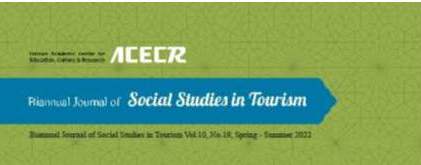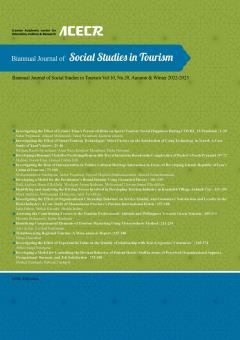-
-
List of Articles
-
Open Access Article
1 - Investigating the Effect of Leisure Time's Perceived Risks on Sports Tourists’ Social Happiness During COVID_ 19 Pandemic
sahar pirjamadi Ahmad Mahmoudi Vahid Saatchian Kamran Romiani -
Open Access Article
2 - Investigating the Effect of Smart Tourism Technologies’ Select Factors on the Satisfaction of Using Technology in Travel: A Case Study of Yazd Visitors
Hashem Reisi amirreza konjkav monfared elahe hosseini -
Open Access Article
3 - Developing a Dynamic Model for Predicting Responsible Travel Intentions Based on the Complexities of Maslow's Needs Pyramid
mahnaz Doosti-Irani Hamed Fallah Tafti -
Open Access Article
4 - Investigating the Role of Interpretation in Politics-Cultural Heritage Interaction in Terms of Developing Islamic Republic of Iran’s Cultural Tourism
Mohammad reza salehi pour akbar pourfaraj Seyed Mojtaba Mahmodzadeh Ahmad golmohammadi -
Open Access Article
5 - Developing a Model for the Destination’s Brand Identity Using Grounded Theory
hadi asghari Hamed Bakhshi Mozghan Azimihashemi Mohammad Hossein Imani khoshkho -
Open Access Article
6 - Investigating the Effect of Organizational Citizenship Behavior on Service Quality, and Customers' Satisfaction and Loyalty in the Hotel Industry: A Case Study of Mazandaran Province’s Parsian International Hotels
jafar bahari mehdi karoubi Shahla Bahari -
Open Access Article
7 - Identifying and Analyzing the Driving Forces Involved in Developing Tourism Industry in Kondoleh Village, Sahneh City
mitra jaliliyan Mohammad Akbarpour Jafar Tavakoli -
Open Access Article
8 - Assessing the Contributing Factors to the Tourism Professionals’ Attitude and Willingness Towards Green Tourism
mostafa mahmoudi Bahar Bishami -
Open Access Article
9 - Identification of Tourism Marketing Factors via Metasynthesis
aziz arfai Farshid Namamian -
Open Access Article
10 - Identifying Componential Elements of Tourism Marketing Using Metasynthesis Method
Ehsan Dorostkar -
Open Access Article
11 - Metatheorizing Regional Tourism: A Meta-analysis Report
Abbasgholi Sangi Noorpour -
Open Access Article
12 - Designing a model to control deviant behavior among hotel staff with respect to perceived organizational support, burnout and job satisfaction
Shahed Zandipak Rabeah Zandipak*
-
The rights to this website are owned by the Raimag Press Management System.
Copyright © 2017-2025







